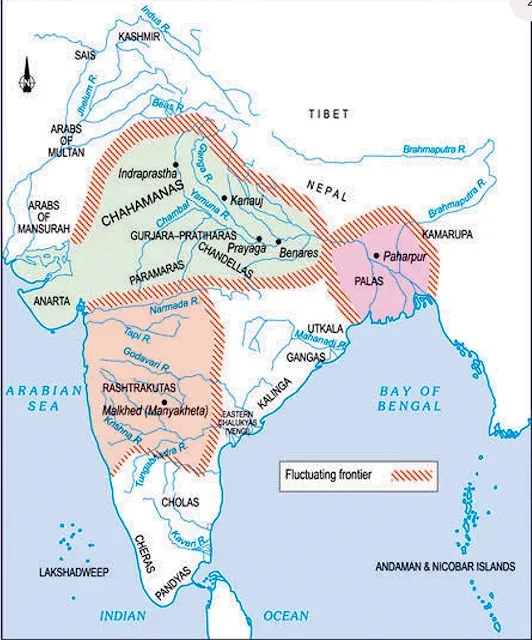New Kings And Kingdoms
Exercise
Let's Recall
| Column A | Column B |
|---|---|
| 1. Gurjara Pratiharas | Western Deccan |
| 2. Rashtrakutas | Bengal |
| 3. Palas | Gujarat and Rajasthan |
| 4. Cholas | Tamil Nadu |
| Column A | Column B |
|---|---|
| 1. Gurjara Pratiharas | Gujarat and Rajasthan |
| 2. Rashtrakutas | Western Deccan |
| 3. Palas | Bengal |
| 4. Cholas | Tamil Nadu |
- Should be owners of the land from which land, revenue is collected.
- Should have their own homes.
- Should be between 35 and 70 years of age.
- Should have knowledge of the Vedas.
- Should be well-versed in administrative matters and honest in all dealings.
- If anyone has been a member of any committee in the last three years, he cannot become a member of another committee.
- Anyone who has not submitted his accounts, as well as those of his relatives, cannot contest the elections.
Answer: Delhi and Ajmer were the two cities under control of the Chahamanas.
5. How did the Rashtrakutas become powerful?
Answer: Rashtrakutas were subordinates to the Chalukyas of Karnataka. In the mid-eighth century Dantidurga, a Rashtrakuta chief, overthrew his Chalukyan overlord. He performed a ritual called Hiranya-garbha with the help of Brahmanas. This ritual was, then, considered to lead the rebirth of the sacrificer as Kshatriya, even if he was not Kshatriya by birth.
6. What did the new dynasties do to gain acceptance?
Answer: The new dynasties gained power and wealth. Thereafter they declared themselves to be maha-samantas or mahamandaleshwara. Many of such kings adopted high sounding titles like maharaja-adhiraja or tribhuvana-chakravartin. They also deputed learned brahmanas to depict them as valiant, victorious warriors. Their activities were recorded in Prashastis. They tried to demonstrate their power and resources by building large temples.
7. What kind of irrigation works were developed in the Tamil Nadu?
Answer: Large scale cultivation was developed in Tamil Nadu and in many cases artificial irrigation became necessary. A variety of methods were used:
- Wells were dug
- Huge tanks were constructed to collect rainwater
- Canals were constructed
8. What were the activities associated with Chola temples?
Answer: The activities associated with chola temples were:
- Chola temples often became the centre of settlements around them.
- These were centres of craft production.
- The produce of this land endowed by both rulers and others, went to maintain all the specialists who worked at the temple and very often lived near it.
- They included priests, garland makers, cooks, sweepers, musicians, dancers, etc.
- Temples were not only places of worship; but also the hub of economic, social and cultural life.
- Amongst the crafts associated with temples, the making of bronze images was the most important.
9. Look at Map 1 once more and find out whether there were any kingdoms in the state in which you live.
Answer:
As we belong to Jammu and Kashmir, therefore here we will discuss about this state:
Kashmir was under the indirect rule of Queen Didda as regent of son Abhimanyu (968 to 980). She took over the throne in 980 to 1003. Didda was succeeded by Sangram Raja who is believed to be the real founder of Lohara kingdom.
10. Contrast the ‘elections’ in Uttaramerur with present day panchayat election?
Answer: The system of election in Uttaramerur was quite different from that of the present day panchayat elections. In the Uttaramerur election, the names of the persons eligible to be members of the committees were written on small tickets of palm leaves. The tickets were put into an earthenware pot. Thereafter a young boy was asked to take out the tickets, one by one for each committee. But the present day panchayat members are elected through a general election.
11. Compare the temple shown in this chapter with any present-day temple in your neighbourhood, highlighting any similarities and differences that you notice.
Answer: Comparison between the present day temples such as the Shiwal Mandir of Anantnag Jammu and Kashmir and the temples shown in chapter:
| Temples Shown in Chapter | Temples in our neighborhood |
|---|---|
| Pyramidal Shape | Triangular in Shape with apex and base |
| Images on Walls | No images on the walls |
| Settlements and land nearby | No such settlement or land nearby |
| Several specialists - priests, Garland makers, sweepers, cook etc | Only priests |
Answer: Taxes collected at present.
- Land tax
- Income tax
- Wealth tax
- Sale tax
- Property tax
- Excise tax VAT (value-added tax)
- Goods and Service Tax (GST)
- Education cess {tax)
- Tax on electricity
- Water tax

.webp)


If you have any doubt, suggestion or question, feel free to contact us.